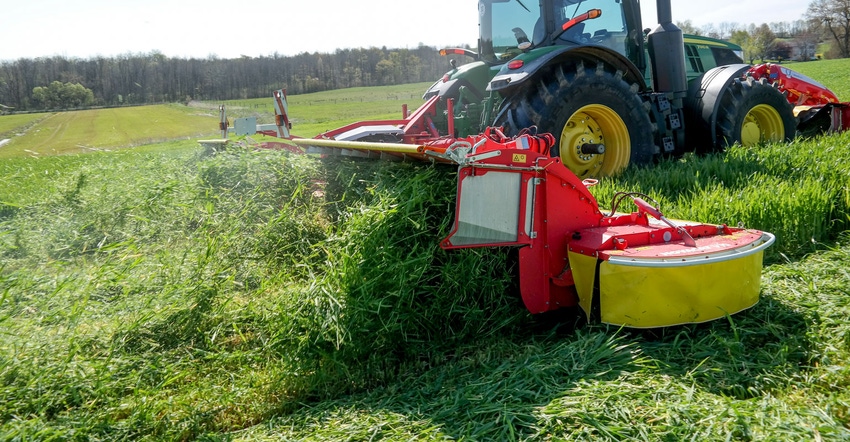April 18, 2019

Triticale has replaced winter barley on Curtis Martin’s 70-cow dairy and small beef operation in Savannah, N.Y.
Tom Kilcer of Advanced Ag Systems in Kinderhook, N.Y., has championed double cropping for its economic and conservation benefits. Triticale accommodates a short rotation with a strong nutritional profile.
With funding from several sources, including the New York Farm Viability Institute, Kilcer’s research has turned triticale into an “overnight success” after two decades of research.
Trials at Martin’s farm produced immediate results.
“Triticale provides high-quality forage with cover crop benefits for soil health and conservation, fewer weeds, and less herbicide application,” Martin says.
The potential to use fall manure to meet the spring needs of winter forage prompted Martin to host a double-crop nitrogen rate study by Kilcer and Cornell’s Quirine M. Ketterings. The study evaluated the effects of five different application rates for spring-applied nitrogen following incorporated manure the previous fall before the triticale was planted.
Cropping schedule benefits
“First and foremost, I wanted to see if triticale could benefit our cropping schedule. We were too late in the summer getting double-crop soybeans no-tilled in. The triticale allows us to get our beans in two weeks earlier,” Martin says.
The earlier planting date translates to spring silage harvest before mid-May for Martin and lets him plant a spring crop to harvest before frost in the fall. He grows about 40 acres of triticale.
Kilcer says the fall planting date is the single most important factor for optimizing a winter forage crop’s spring potential yield. He recommends planting triticale 10 days to two weeks before the locally recommended winter wheat planting date.
“We want to plant for a minimum seven to eight weeks of fall growth, so planting before mid-September is optimal and a fall application of nitrogen boosts the number of tillers, which sets the triticale’s spring yield potential,” Kilcer says.
“Planting as early as possible can make as much as a 30% difference in yield opportunity,” he adds. “Some of our manure-applied trials have produced phenomenal 4.5 tons dry matter yield per acre based on planting date as the key.”
More crude protein
One thing that surprised Martin was triticale’s response to the nitrogen application. As part of the trials, he applied 6,000 pounds of hog manure, incorporated within one hour.
“I was surprised that we didn’t get a bigger difference in yield with nitrogen applied, but we did gain crude protein. With soybean meal roughly $400 per ton feeding out at 13% to 14% protein, compared to the triticale at 18% to 20% protein, it definitely pays to be growing the triticale,” Martin says.
As the nitrogen rate increased, so did the triticale’s crude protein: from 9.5% in the zero-N plots to 12.8% in the 30-pound N plots and 19.2% in the 120-pound N plots. Yield averaged 2.85 tons of dry matter per acre across the trial.
At the 120-pound N rate, the triticale produced 1,140 more pounds of crude protein per acre than the zero-N rate.
So, for $84 worth of nitrogen fertilizer, Martin harvested $211 more soybean meal equivalent per acre, a direct savings for the farm.
What was the effect on milk production?
“Triticale is a good feed with high digestibility anytime,” he says. “My cows did quite well with it, especially in the summer. The high sugar, high digestibility of the triticale helped them keep milk production from dropping off due to heat stress.”
Benefits of triticale
Here are 11 reasons to like triticale:
• Provides a high-quality, high-protein, easily-digestible feed for dairy cows.
• Can help increase milk production compared to an alfalfa-grass, corn silage feeding program.
• Uses on-farm manure at a time that reduces overwintering manure storage.
• Reduces the need for purchased nitrogen, helping reduce farm costs.
• Provides soil health and soil conservation benefits.
• Works well in short rotations.
• Allows more nitrogen application for higher forage yield without crop lodging.
• Harvesting at first-cut haylage time facilitates spring planting.
• Superior weed control to reduce herbicide costs.
• It is winter hardy.
• Because of its high fiber digestibility, farmers who add triticale during hot summer temperatures do not have a “summer slump” in production.
Dunn writes from her farm in Mannsville, N.Y.
About the Author(s)
You May Also Like




